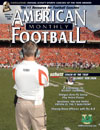AMERICAN FOOTBALL MONTHLY THE #1 RESOURCE FOR FOOTBALL COACHES
Article CategoriesAFM Magazine
|
Schutt Sports College Coaches of the Yearby: David Purdum© More from this issue FCS - DIVISION I-AA Mark Farley Record: 12-1, first Gateway Conference school to complete a perfect 11-0 season; upset Iowa State. Offense: Primarily a one-back, Shotgun West Coast offense, with 30-40% mix of I-formation. Defense: 4-3 Key Stat: Talk about balance – the Panthers averaged 227 rushing yards and 229 passing yards this season. The difference in Mark Farley’s football this season compared to last is simple: “We were good every week,” said Farley. “It wasn’t the great games and then the OK games. We were very consistent. I credit that to the off season.” In 2006, Northern Iowa ended the season ranked 17th in the nation and was left out of the 16-team I-AA playoffs. The next day, Farley called a team....The full article can only be seen by subscribers. Subscribe today!
|
|
|||||||
| HOME |
MAGAZINE |
SUBSCRIBE | ONLINE COLUMNISTS | COACHING VIDEOS |
Copyright 2025, AmericanFootballMonthly.com
All Rights Reserved





